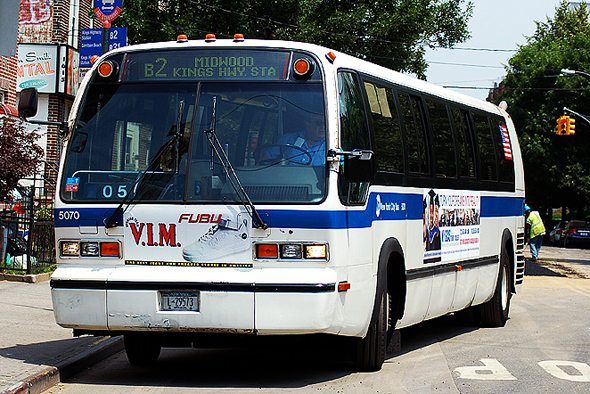The MTA’s Secret Plan to Eliminate the B2

THE COMMUTE: Last week, I wrote about the MTA’s sinister plot to destroy the B64, which they already have partially accomplished. They are also most likely planning to eliminate the B2, once one of the most profitable and successful bus routes in Brooklyn, operating every two minutes during rush hours in the 1950s. Today, overnight and weekend service have already been eliminated and service at other times is infrequent. I previously discussed reasons for the downward ridership trend on the B2. The next step is to reduce it to a rush-hour only route, then to finally discontinue it entirely.
It is widely agreed that, since the MTA acquired the B100 from the Command Bus Company, routes along Avenue R and Quentin Road, one block away, are duplicative and unnecessary. The logical solution, considered by the MTA in 1981 when they first were contemplating taking over the privately operated bus lines, was to extend the B2 along Avenue U into Mill Basin, taking over that portion of the B100. Since the B9 has since been extended to Kings Plaza, another possibility is to reroute the B2 at Flatbush Avenue, having it miss Kings Plaza and turn onto Fillmore Avenue, continuing into Mill Basin.
The alternative of just eliminating the B2 and retaining the B100 makes little sense because there still would be bus routes one block apart (B100 and B31) for a short distance and, with stops on the B100 more widely spaced than on the B2’s and the B100’s routing, it would not serve Marine Park as well as the B2. Eliminating the B2 would also force some riders to shift to the B3 along Avenue U for a longer more indirect trip to Manhattan. Almost as inconvenient for Marine Park residents would be yet another alternative to eliminating the B2 — that is to reroute the B100 from Quentin Road to Avenue R, running it straight to Flatbush Avenue to Fillmore Avenue. That alternative requires residents who presently do not have a bus on their street to accept one, something the MTA tries to avoid. So my prediction is that they will choose to just eliminate the B2 and this would be their primary reason: The city subsidizes the B100, but not the B2.
The MTA accepted taking over the privately operated routes only under the condition that the city would continue its practice of subsidizing operating losses as they had been doing when the routes were privately operated. The MTA’s overwhelming concern with minimizing operating losses, rather than best serving the public, will lead them to the decision to eliminate the B2.
If the MTA were concerned with the latter, rather than seeking to eliminate the route, they would have been tried years ago to expand its use by extending it westward along Avenue P and 65th Street to give it more of a purpose. This has never been done because the MTA never wanted to operate service along 65th Street as well as 60th Street a quarter-mile away, where the B9 presently operates. I know this because, in 1978, while at the Department of City Planning, I made this proposal, which was rejected for exactly that reason. The walk to an east-west bus between 65th Street and Bay Ridge Parkway (75th Street), exceeds their one-quarter-of-a-mile walking distance guideline, which was part of my rationale for a new 65th Street service. However, since the service guidelines are used only as justification to eliminate routes, never to extend them, it did not matter.
Last week, I discussed the B64 and the sinister plot to eliminate Bath Avenue service because it is slightly over a quarter-of-a-mile away from the B1 along 86th Street. That is just slightly more than the distance between 60th and 65th streets, which the MTA stated they consider too close for two parallel bus routes.
MTA Chairman Jay Walder supposedly prides himself in transparency, even creating a Transparency Tab on the MTA’s newly revamped website. However, next December’s service adjustments are tucked away in a folder called “Board and Board Materials,” hidden in a 155-page document labeled June 2011 Transit Committee Meeting with the discussion beginning on Page 123. How transparent is that?
The facts are that nothing the MTA does is transparent. There are secret agendas. How many of you understood what I was talking about last week when I stated that changes in service frequencies would result in increasing the guideline capacity from X percent to X percent? Was it easier to understand than the tax code? Increases in guideline percentages are not understandable without an explanation of what the guidelines actually are, which are nowhere to be found. Transparency in the planning process is most important if the MTA is ever to be trusted.
The Commute is a weekly feature highlighting news and information about the city’s mass transit system and transportation infrastructure. It is written by Allan Rosen, a Manhattan Beach resident and former Director of MTA/NYC Transit Bus Planning (1981).




